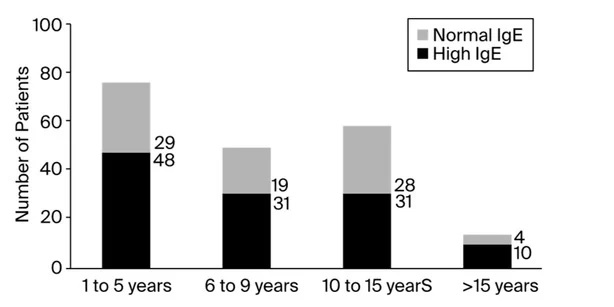Immunoglobulin E (IgE) is an antibody produced by the immune system, primarily in response to allergens such as pollen, dust mites, or certain foods. The levels of IgE in the blood can vary based on a variety of factors, including age, environmental exposure, and health conditions. Understanding normal IgE levels by age is crucial for diagnosing allergies, and immune system disorders, and monitoring treatment efficacy. This article explores normal IgE levels by age in both kU/L (kilounits per liter) and IU/mL (international units per milliliter), as well as how these values differ in India compared to other regions.
What Are IgE Levels?

IgE is one of five major classes of antibodies produced by the immune system. It plays a vital role in the body’s defense mechanisms against parasitic infections and allergic reactions. IgE levels are typically measured when doctors suspect an individual may be experiencing allergies or other immune system-related issues. High IgE levels are commonly associated with conditions like hay fever, asthma, and eczema. On the other hand, low IgE levels may indicate an immune deficiency or a compromised immune system.
Why Are IgE Levels Important?
Measuring IgE levels helps healthcare professionals assess the likelihood of allergic reactions or sensitivities to certain allergens. Elevated IgE levels may signal an allergic condition, but they can also be seen in other medical conditions, such as autoimmune disorders or some parasitic infections. Therefore, it is important to consider age-related normal IgE levels to accurately interpret test results.
Normal IgE Levels by Age in kU/L
1. Normal IgE Levels in Children (0-18 Years)
IgE levels in children tend to vary significantly as they grow. Normal IgE levels for children can range widely, but generally:
- Infants and Toddlers (0-2 years): Normal IgE levels range from 0 to 20 kU/L. This period typically sees low IgE levels as the immune system is still developing.
- Children (2-6 years): IgE levels may increase slightly, ranging from 1 to 50 kU/L. This is the age when many children develop allergies such as food or environmental allergies.
- School-age children (6-12 years): IgE levels generally rise further, ranging from 10 to 100 kU/L, as their immune system encounters more allergens.
- Teenagers (12-18 years): The levels may be as high as 20 to 150 kU/L, with many teenagers experiencing environmental allergies, especially to pollen and dust mites.
2. Normal IgE Levels in Adults (18+ Years)
- Young Adults (18-30 years): Normal IgE levels for young adults can range from 20 to 150 kU/L, depending on exposure to allergens and genetics. This is when allergic rhinitis and asthma may become more pronounced.
- Middle-aged adults (30-50 years): For adults in this age group, normal levels typically range from 10 to 200 kU/L. Exposure to environmental allergens continues to be a factor.
- Older Adults (50+ years): For adults over 50, IgE levels can be more variable, often ranging from 10 to 100 kU/L, as many individuals experience a reduction in allergies over time.
Normal IgE Levels by Age in IU/mL
IgE can also be measured in international units per milliliter (IU/mL). While kU/L and IU/mL are both standard units of measure, 1 kU/L is equal to 1000 IU/mL. The conversion between the two units can sometimes vary, but typically:
- Normal IgE levels in children are often found between 0-200 IU/mL.
- In adults, normal IgE levels range from 20-300 IU/mL, again depending on age, exposure to allergens, and health conditions.
Normal IgE Levels by Age in India
Age-Specific IgE Levels in India
IgE levels in India can vary somewhat due to environmental factors, such as air pollution, local allergens, and dietary differences. While international ranges are commonly used, Indian populations may experience differences in IgE levels based on regional allergens.
- Children in India often show higher IgE levels compared to children in Western countries. This is especially true in urban areas with high levels of air pollution. IgE levels may range from 10 to 60 kU/L in young children, especially those living in cities like Delhi or Mumbai, where allergens like dust mites, pollens, and vehicle exhaust are prevalent.
- Adults in India may show IgE levels ranging from 20 to 200 kU/L. In individuals with common conditions such as asthma or allergic rhinitis, IgE levels may exceed these ranges.
- Elderly individuals in India typically experience a decline in IgE levels, especially those over 60 years of age. Their levels may be lower than those found in younger adults, ranging from 10 to 100 kU/L.
Cultural and dietary differences, such as higher exposure to certain types of food allergens, may influence the average IgE levels in the Indian population. Additionally, air quality in urban regions plays a significant role in altering immune responses.
Interpreting IgE Test Results
While there are normal IgE levels based on age, it is crucial to interpret these results in the context of an individual’s overall health and medical history. Elevated IgE levels can indicate an allergic response, but they are not exclusive to allergies. Some individuals may have high IgE levels without any apparent allergic symptoms, while others may have normal levels and still experience severe allergic reactions.
Factors Influencing IgE Levels
Several factors can influence IgE levels, including:
- Genetics: Family history of allergies can lead to higher IgE levels.
- Environmental exposure: Living in areas with high pollution or frequent exposure to allergens like pollen, mold, and dust mites can raise IgE levels.
- Dietary habits: Certain foods, such as peanuts, shellfish, and eggs, may cause elevated IgE levels in sensitive individuals.
- Health conditions: Conditions like asthma, eczema, and hay fever can lead to high IgE levels.
- Infections: Some viral and parasitic infections can also cause IgE levels to rise.
When to Consult a Doctor About IgE Levels
If you or your child are experiencing symptoms such as frequent sneezing, itchy eyes, skin rashes, or wheezing, it may be time to consult a doctor and have IgE levels tested. Doctors typically measure total IgE levels, but they may also perform specific tests to identify particular allergens.
Key Symptoms to Watch For:
- Persistent coughing
- Sneezing or nasal congestion
- Itchy or watery eyes
- Skin rashes or eczema
- Breathing difficulties
If your IgE test results are elevated, your doctor may conduct additional tests or recommend treatment options such as antihistamines, immunotherapy, or lifestyle adjustments to minimize exposure to allergens.
Final thought
Normal IgE levels vary by age, with infants and young children typically having lower levels, and adults having higher levels as they encounter more environmental allergens. In both India and around the world, IgE levels can fluctuate based on regional environmental conditions, dietary habits, and genetic factors. Understanding IgE levels by age is important for diagnosing allergic conditions and managing treatment. Always consult with a healthcare provider to interpret IgE test results in the context of your health profile.
If you notice symptoms of allergies, don’t hesitate to consult with your doctor for proper testing and










